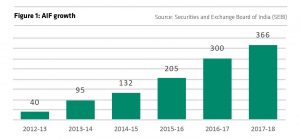Global Custodian: What accounts for the growth of AIFs in India?
 Christophe Beelaerts: The Securities and Exchange Board of India (SEBI) introduced regulations to manage AIFs in 2012 and in the past five years the number of such funds has grown eightfold. According to SEBI statistics, AIFs currently have around US$22bn in commitment.
Christophe Beelaerts: The Securities and Exchange Board of India (SEBI) introduced regulations to manage AIFs in 2012 and in the past five years the number of such funds has grown eightfold. According to SEBI statistics, AIFs currently have around US$22bn in commitment.
AIFs face a bright future, since the appetite for alternative investments in India, including allocations to real estate and private debt is likely to keep growing. Moreover, foreign interest has been boosted by the decision to allow overseas investment in AIFs.
GC: Which structures are most popular for AIFs in India?
CB: Although AIFs can be set up as a trust, an LLP or a company, some 95 per cent of funds are registered as Trusts. These provide high levels of client confidentiality, low compliance requirements and are easy to run.
GC: What about the tax implications?
CB: When it comes to Category I and Category II AIFs (See box), business income is taxed at the AIF level; full pass-through for income from investments, such as capital gains, dividends and interest, is allowed. Losses are retained at the fund level and not passed on to the investors.
Category III AIFs do not benefit from pass-through status, which means income is taxed at the fund level as per the general taxation principles applicable to the AIF’s structure, but the same income could be taxed at both the fund level and the investor level, and in some circumstances the AIF’s entire income might be taxed at the Maximum Marginal Rate (MMR). Investors have no certainty as to whether the AIF’s income will be classified as capital gains or as business income.
 GC: Are there any particular challenges faced by AIFs with foreign capital?
GC: Are there any particular challenges faced by AIFs with foreign capital?
CB: Though Category III AIFs (most of which are trusts) have proved popular as a means of exposure to Indian securities, there are indeed tax issues around foreign investors. If a Category III AIF has just one non-resident investor or Foreign Capital/Investments then every restriction applying to Foreign Portfolio Investors applies to the entire fund.
GC: How does interest in AIFs compare to mutual funds?
CB: AIF’s are still some way behind mutual funds, which have around US$330 billion in assets under management. This is partly because AIFs have a relatively limited audience as they deal in more complex, higher-risk investments than mutual funds, and require a minimum investment of one crore rupees (around USD 160,000).
Although AIFs are unlikely to catch up with mutual funds in terms of their AuC, they are growing fast. But as is clear from the issues discussed above, the sector would benefit from the clarification of a number of grey areas relating to structure and taxation. Investors should therefore pay close attention to future amendments from regulators to see if these issues are addressed. 